A wireless microphone gives you freedom of movement onstage or in front of the camera. And the best wireless microphones provide the same, or even better, sound quality as a wired system.
When you’re shopping for a wireless microphone system, there are always a few factors to consider. Will you benefit from using digital instead of analog signal transmission? Would you prefer a handheld microphone or a lavalier mic? And will you run multiple mics at the same time, or only one?
Let’s take a quick peek at the top picks for wireless microphones before we dive into the reviews below.
The top wireless microphones at a glance
| Wireless Mic | Top features | |
|---|---|---|
| Shure SM58 | Durable handheld mic for singers and speakers Upper midrange presence peak + bass rolloff Frequency response: 50 to 15,000 Hz Variable compression ratio for high quality sound Easy to use with UHF SLX2 Wireless System Automatic frequency selection and transmitter setup | Check Price |
| Sennheiser EW145 | Wide range of UHF frequencies eliminates interference 5-band equalizer puts power over frequency response (sound quality) into the hands of the user Super-cardioid pickup pattern isolates user’s voice from nearby instruments and room noise Auto-lock keeps settings from accidental changes Soundcheck mode on receiver displays continuous updates of signal strength and levels | Check Price |
| Shure PG58 | Durable handheld mic for both singers and speakers Great for live vocal performances Frequency response range 60Hz to 15kHz 2 AA batteries last up to 14 hours 300-foot range, line of sight On/off button on mic BLX transmitter automatically selects the most clear frequency | Check Price |
| GTD Audio G-622H | Good sound at a budget-friendly price Maximum range of UHF signal is 500 feet Battery life up to 12 hours Automatic selection of open channel Automatic synchronization of mic and receiver It’s possible to link up to 30 mics and 15 receivers Both XLR and 1/4” outputs | Check Price |
| Audio-Technica ATR288W | Compact system, easier to manage than rack mount Comes with both handheld and lavalier mics Receiver and mics have 100 to 300-foot range Comes with camera mount adapter and earphone Battery life up to 8 hours | Check Price |
| PylePro PDWM3375 | Inexpensive for home use or occasional events Comes with two handheld mics plus receiver 8 UHF channels to avoid interference Can be connected to other sound equipment | Check Price |
| Fifine Dual Channel Wireless Handheld Microphone | Comes with two handheld mics plus receiver Mics pair with receiver automatically Individual volume controls for each mic Can add effects like echo and background music Can add a third microphone if desired Low battery warning light | Check Price |
| Sennheiser AVX Digital Wireless Microphone System | Sturdy dynamic handheld microphone eliminates room or street noise Mic has 10-hour battery life, easy to recharge through USB connector Battery life indicators on mic and receiver Digital transmission of signal means it’s rare to have audio loss from interference 24-bit, 48k sampling, plus AES-256 encryption Operates in license-free 1.9GHz DECT range Can run up to 12 AVX systems together Automatically switches channel if there is interference Transmitting power up to 250mW but adapts to distance to conserve power Dynamic Range feature automatically manages levels to avoid clipping No cables needed to plug receiver into XLR input Comes with XLR to 3.5mm adapter cable Receiver is very compact 2-year warranty | Check Price |
| Shure BLX14/CVL | Small mic with cardioid pickup pattern Great for presentations, sermons Receiver finds open channel automatically Simple to use, professional product, well-known manufacturer Maximum 300-foot operating range | Check Price |
| PylePro PDWM3400 | Good for presentations, sporting events, weddings, fitness classes, and more Can join more than one mic system together at the same event on different channels Receiver offers 8 selectable channels to avoid interference Each mic has its own adjustable volume control and channel selector Low battery warning when 1 hour is left Output from XLR or 1/4-inch jacks 1-year warranty | Check Price |
Shure SLX2/SM58—Best All Around Handheld Wireless Mic For Vocalists and Speakers
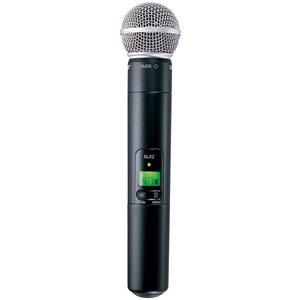
The Shure SM58 microphone is well-known among sound professionals because it’s both very durable and it has a rich, dynamic sound. It handles being on-stage indoors or outside, on the road, or in the studio equally well. And setup with the SLX Wireless System is quite easy.
Even though this microphone is wireless, it doesn’t skimp on its upper-midrange presence peak. What does this presence peak mean? When you’re speaking into the mic, it makes you seem closer to the listener, more “present.”
Beside the boost in the upper range, the SM58 brightens up the tone of the midrange frequencies and adds bass rolloff. The rolloff prevents too much booming bass effect, or proximity effect. In other words, this is a microphone specifically designed for singers and speakers that want to sound crisp and clear.
The unidirectional cardioid pickup pattern on the SM58 is typical of handheld mics. It ignores most background noise in favor of amplifying the user’s voice. It also has a built-in spherical pop and wind filter that cuts down on wind noise, breath sounds, and distracting plosives. Plus, the internal shock-mount system and external steel grille stand up to rough handling.
If you look at the body of the microphone, there is a small LCD display. It reveals the UHF frequency of the mic as well as the battery’s status. And right below the screen is a small mute button, which is handy for silencing the mic without turning it off.
When you select the SM58 microphone you want, you’ll be choosing one from a range of pre-programmed frequency bands, like “H5” or “J3.” Make sure you choose the same frequency range for the SLX receiver, too. But once you’ve got a matched set, they link together automatically, making setup super easy and fast.
The SLX4 receiver supports up to 20 compatible systems at a time with 960 selectable frequencies. That means you can run other mics with it, not just the SM58. With this much bandwidth available, it won’t be hard to set up an interference-free connection for all of them. And since the Shure SM58 mics use a variable compression ratio, not fixed, the sound quality is very good indeed.
On the rear of the SLX receiver, you’ll find both XLR and ¼-inch outputs so you can run the sound out to your system. This receiver is designed to work equally well in the studio or on the road as it can be powered by either AA batteries or mains electricity. It’s the perfect match for the SM58 wireless microphone.
- Durable handheld mic for both singers and speakers
- Upper midrange presence peak + bass rolloff
- Frequency response: 50 to 15,000 Hz
- Variable compression ratio for high quality sound
- Easy to use with UHF SLX2 Wireless System
- Automatic frequency selection and transmitter setup
- SLX receiver supports up to 20 mics at once
- SLX receiver is portable or rack-mountable
- Might be expensive for occasional home use, more of a professional tool
- UHF analog, not digital
Click here to purchase Shure SLX2/SM58 on Amazon.com!
Sennheiser ew 145 G3-A-US—Best UHF Mic For Professionals Who Want Precise Control
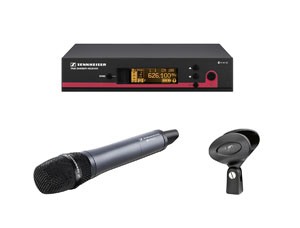
Why might you prefer the Sennheiser ew 145 over the Shure SM58? The answer might depend on whether you like the super-cardioid pickup pattern instead of cardioid. The super-cardioid pattern of the Sennheiser mic is better at isolating the speaker’s voice from room noise or nearby musical instruments.
You might also like the 5-band equalizer which allows you to adjust how you sound, whether you want a flat response or bass roll-off. This is different from the SM58 that does the adjusting for you.
Then there is the soundcheck mode on the EM100 receiver. It continuously displays the audio levels and signal strength from the microphone. Plus, there is an auto-lock feature that prevents the user from changing the mic settings on accident during an exciting performance.
With almost double the number of tunable UHF frequencies of the Shure SLX receiver, the EM100 eliminates the possibility of interference interrupting a show. And setup is very easy with just the push of a button to link the microphone and the EM100.
- Wide range of UHF frequencies eliminates interference
- 5-band equalizer puts power over frequency response (sound quality) into the hands of the user
- Super-cardioid pickup pattern isolates user’s voice from nearby instruments and room noise
- Auto-lock keeps settings from accidental changes
- Soundcheck mode on receiver displays continuous updates of signal strength and levels
- Might be too expensive for occasional home use, more of a professional tool
- UHF analog, not digital
Click here to purchase Sennheiser EW 145 on Amazon.com!
Shure BLX288/PG58—Best Deal For Multiple Professional Microphones
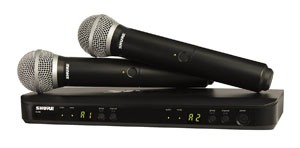
When you need two microphones for live performances, you can save money with this set from Shure. It comes with two of the PG58 mics plus a BLX receiver. Just make sure you match the frequency range between the microphone and the receiver, like “H8” for both.
A lot of people want to know the difference between the Shure SM58 and the PG58, especially since the PG58 is less expensive. Their frequency response ranges are a bit different, with the SM58 tailored for either studio work or live shows, while the PG58 is really best for live vocals only.
While both are dynamic mics with cardioid pickup patterns, the SM58’s mic capsule has a pneumatic shock mount for better durability and less handling noise. It also has a built-in pop filter against wind noise and plosive consonants. But that doesn’t mean that the PG58 isn’t durable, or it doesn’t have great audio quality. In fact, many people can’t tell the difference in sound between the two microphones.
The BLX receiver links up with the PG58 mic with just the push of a button. It automatically selects the clearest open frequency in the area. And while it doesn’t specifically reveal individual audio levels, it does show if there is overload or clipping.
There are a few other features that might sway you to choosing the PG58 mic. There is an on/off button to let you take a real break, not just mute your performance. The mic works up to 300 feet away from the receiver as long as there is line of sight. And two simple AA batteries last up to 14 hours.
- Durable handheld mic for both singers and speakers
- Great for live vocal performances
- Frequency response range 60Hz to 15kHz
- 2 AA batteries last up to 14 hours
- 300-foot range, line of sight
- On/off button on mic
- BLX transmitter automatically selects the most clear frequency
- UHF analog, not digital
Click here to purchase Shure BLX288/PG58 on Amazon.com!
GTD Audio G-622H—Best Budget Setup with Handheld Mics

The GTD Audio G-622H Wireless Mic System is possibly the best budget-friendly setup for managing multiple microphones. It’s possible to link up to 15 GTD Audio receivers and 30 mics at a time. And it’s not hard for beginners to use. Each mic transmitter and receiver synchronize automatically on the best open channel.
While the maximum range is listed as 500 feet, that’s only for line of sight because this is a UHF system. It operates between 610MHz to 680MHz, so you can verify that there won’t be interference with other systems where you operate it.
The two XLR and one ¼-inch mixed output let you link in your sound equipment to manage levels. But each channel allows you to control its volume independently. And there is a tone lock squelch to protect against RF interference, too.
As for the mics themselves, they run up to 12 hours on two AA batteries each. Customers report that they sound good when used for speaking events, such as church services.
- Good sound at a budget-friendly price
- Maximum range of UHF signal is 500 feet
- Battery life up to 12 hours
- Automatic selection of open channel
- Automatic synchronization of mic and receiver
- It’s possible to link up to 30 mics and 15 receivers
- Both XLR and 1/4” outputs
- UHF analog, not digital
Click here to purchase GTD Audio G-622H on Amazon.com!
Audio-Technica ATR288W—Best Compact VHF Set With Both Lavalier and Handheld Mics
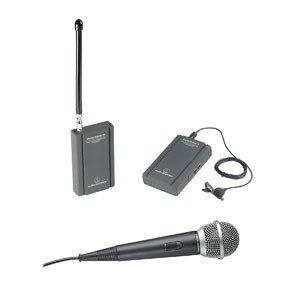
Forget the rack mount receivers. The ATR288W TwinMic System from Audio-Technica is versatile and compact. It includes both a dynamic handheld mic and a lavalier condenser mic paired with a very small VHF receiver. It’s perfect if you want to plug it into a DLSR camera—it even comes with a camera mount adapter.
Imagine how you can record on-the-street interviews using both mics. Or use either one of the microphones to broadcast a live show. Either mic is designed to sound great for vocals. The dynamic handheld mic has a unidirectional pickup pattern, and the lavalier mic has omni-directional pickup.
While the range is only 100 to 300 feet, that’s plenty for most purposes. The most common uses for this set are for video recordings, podcasts, karaoke, churches, schools, and business presentations.
The mics and receiver run off 9-volt batteries for up to 8 hours. The compact FM Superheterodyne receiver has two channels, one for each microphone. Those channels are 169.505 MHz and 170.305 MHz. You can attach and adjust the rubber-coated antenna to improve reception. Plus, the receiver comes with an earphone so you can listen to the transmission in real time.
- Compact system, easier to manage than rack mount
- Comes with both handheld and lavalier mics
- Receiver and mics have 100 to 300-foot range
- Comes with camera mount adapter and earphone
- Battery life up to 8 hours
- VHF analog, not digital
- Shorter range than UHF
- Only two channels
Click here to purchase Audio-Technica ATR288W on Amazon.com!
PylePro PDWM3375—Inexpensive For Home Use Or Weddings

While the PylePro PDWM3375 system has one of the smallest operating ranges of all the mics in our reviews, it has a lot of bang for the buck. While you wouldn’t want to go on tour with this setup, it’s fine for karaoke parties, a wedding, or a little DJ work.
The receiver can sit up to 50 meters, or 164 feet, from either one of the handheld mics and still pick up the signal. There are 8 selectable UHF channels so you can avoid problems with interference. And the receiver has a volume knob to help you manage volume levels, too. It has both 1/4-inch and XLR output connectors for output to an amplifier or other sound equipment.
The two handheld dynamic mics that come in this set will show a red light if the batteries are getting low. Users report that the mics have decent sound although they aren’t especially durable.
- Inexpensive for home use or occasional events
- Comes with two handheld mics plus receiver
- 8 UHF channels to avoid interference
- Can be connected to other sound equipment
- Short UHF operating range of 164 feet
- Not especially durable
Click here to purchase PylePro PDWM3375 on Amazon.com!
Fifine Dual Channel Wireless Handheld Microphone—Very Inexpensive Handhelds For Karaoke And Home Use
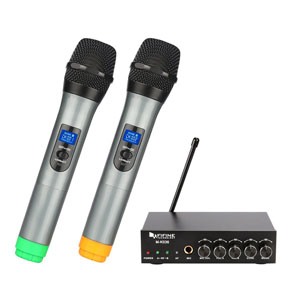
You may find the Fifine UHF Wireless Microphone System K036 at an even lower price than the PylePro one we reviewed above. Again, this isn’t top of the line audio equipment, but it’s not meant to be. This is a nice setup for folks who want to do karaoke parties, speak in churches or clubs, or make presentations.
The system includes two handheld dynamic microphones and a receiver. The mics automatically pair with the receiver, and they are color-coded so you know which corresponds to each control on the receiver.
The receiver also has a ¼-inch mic input jack so you can add a third microphone. There are separate volume controls for each mic, plus you can add both echo effects and background music. And there’s a 3.5mm output jack so you can run the sound out to a speaker or audio system.
Unfortunately, the UHF frequency is fixed at 672.5 to 684.5 MHz, so you can’t make adjustments to a new channel if there is interference. But most users who comment online haven’t reported a problem with this.
- Comes with two handheld mics plus receiver
- Mics pair with receiver automatically
- Individual volume controls for each mic
- Can add effects like echo and background music
- Can add a third microphone if desired
- Low battery warning light
- Fixed carrier frequency
- Not the most durable equipment
Click here to purchase Fifine Dual Channel Wireless Handheld Microphone on Amazon.com!
Sennheiser AVX Digital Wireless Microphone System—Best Professional Mic for Street Interviews, Documentaries, Videography
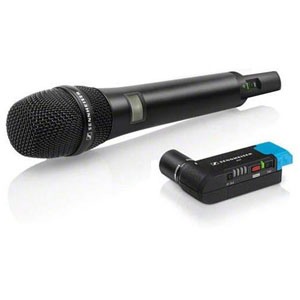
The Sennheiser AVX Digital Wireless Microphone System 835 Handheld Set is the videographer’s dream setup for doing interviews. It comes with both a durable dynamic handheld microphone and a very compact digital receiver. The receiver plugs neatly into any camera with an XLR input. Then the receiver switches on and off automatically with P48 Phantom Power from the camera.
There is basically almost no user intervention required. It’s really plug and play. The microphone and receiver synch automatically. The receiver chooses the best open frequency to avoid interference, and it even switches channels if needed during the transmission. It also automatically sets the best recording levels. This is an AVX feature from Sennheiser. They call it Dynamic Range.
While the transmission is in progress, it’s encrypted with AES-256 protection so no one can listen in. The handheld microphone, while not discreet, is ideal for street interviews or use where there is room noise. It focuses in on the speaker’s voice and rejects other sounds. If you’re an up and coming documentary videographer, this might be the perfect system for you.
- Sturdy dynamic handheld microphone eliminates room or street noise
- Mic has 10-hour battery life, easy to recharge through USB connector
- Battery life indicators on mic and receiver
- Digital transmission of signal means it’s rare to have audio loss from interference
- 24-bit, 48k sampling, plus AES-256 encryption
- Operates in license-free 1.9GHz DECT range
- Can run up to 12 AVX systems together
- Automatically switches channel if there is interference
- Transmitting power up to 250mW but adapts to distance to conserve power
- Dynamic Range feature automatically manages levels to avoid clipping
- No cables needed to plug receiver into XLR input
- Comes with XLR to 3.5mm adapter cable
- Receiver is very compact
- 2-year warranty
- Expensive for home use
- Short range, maximum about 160 feet line of sight
- Batteries must be recharged
- Receiver only has 5-hour battery life
Click here to purchase Sennheiser AVX Digital Wireless Microphone System on Amazon.com!
Shure BLX14/CVL—Professional Sound For Presenters, Compact Size, Easy To Use

When you want to give a professional presentation, you need reliable, high-quality audio. The CVL-H10 lavalier mic and body pack transmitter will get your message across with clear, crisp sound. The discreet mic has a condenser cartridge with a cardioid pickup pattern so it focuses only on the sound of your voice. It comes with windscreens to cut down on distracting plosives, too.
But this professional-level system doesn’t require specialized training to use. With the push of a button, the BLX receiver automatically selects the best open frequency to avoid interference. The signal transmits up to 300 feet, line of sight. And the body pack transmitter has an on/off button so you can have a word in private.
- Small mic with cardioid pickup pattern
- Great for presentations, sermons
- Receiver finds open channel automatically
- Simple to use, professional product, well-known manufacturer
- Maximum 300-foot operating range
- Plastic housing on the receiver
Click here to purchase Shure BLX14/CVL-H10 on Amazon.com!
PylePro PDWM3400—Best Inexpensive Multiple Lavalier Mic Package
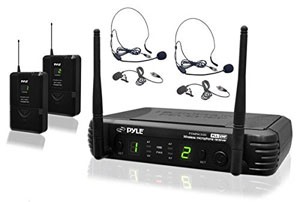
The PylePro PDWM3400 package includes two lavalier microphones, two headsets, and a receiver. This UHF system has a maximum operating range of 164 feet, so it’s great for small events and classes. You can also operate multiple systems together in the same area because there are 8 UHF channels to avoid interference.
The lavalier mics come with headsets so you can listen in on the transmission. Each mic is omnidirectional and comes with a clip for easy positioning. And both the body pack transmitters and the receiver have adjustable antennas so you get the maximum range possible.
Each mic and body pack transmitter has its own volume control and channel selector. And each is powered by two AA batteries. When their charge is getting low, the LED light indicator turns red as a warning.
Several users have commented that this inexpensive package was just what they needed for a wedding, a sermon, or a presentation.
- Good for presentations, sporting events, weddings, fitness classes, and more
- Can join more than one mic system together at the same event on different channels
- Receiver offers 8 selectable channels to avoid interference
- Each mic has its own adjustable volume control and channel selector
- Low battery warning when 1 hour is left
- Output from XLR or 1/4-inch jacks
- 1-year warranty
- Short operating range of 164 feet
- Omnidirectional mics can pick up room noise, not just the speaker’s voice
Click here to purchase PylePro PDWM3400 on Amazon.com!
Buyer’s Guide for Selecting the Best Wireless Microphone
Now that you’ve seen the best wireless microphones, let’s do a crash course in how to choose the best mic for your needs.
Microphone types—handheld, headset, lavalier
There are three main types of microphones in our reviews today. Each type has pluses and minuses depending on what you need and how you use them.
Handheld
Handheld wireless mics have their own built-in transmitter so there’s no body pack to wear. These are the dynamic mics that lead vocalists have on stage, or the ones that videographers use for interviews. It’s also the best type for when you need to pass a microphone around, like at a wedding toast.
Handheld mics are usually cardioid or super-cardioid, so they focus on the sound in front of them and ignore room noise.
Headset
A headset microphone is the type often worn by fitness instructors or singers who dance. It requires the use of a body pack transmitter. The mic itself might be unidirectional or omnidirectional (more on that in a moment).
Lavalier
A simple lavalier microphone doesn’t require the use of a headset, but does need a body pack transmitter. These small clip-on mics are perfect for stage actors, worship leaders, and speakers giving presentations—basically anyone who moves around and may need the use of both hands.
There are two kinds of microphone pickup patterns, omnidirectional and unidirectional. Omnidirectional mics amplify both the speaker’s voice and any sounds nearby, so it’s really best for quiet places like a lecture hall or classroom. A unidirectional mic is much better for noisy environments like a gym or a public venue outdoors.
Signal transmission types—UHF, VHF, and digital
When you choose a wireless microphone system, it matters what kind of technology it uses to transmit the audio signal. You’ll want to consider this because it can make or break your setup.
Analog UHF
UHF is the most common signal that most wireless mic systems use. It uses part of the radio wave spectrum. Interference can affect the quality of the sound you’ll hear, just like when you hear distortions while listening to a radio station.
The professional quality UHF systems offer multiple channels to help you work around interference. Many of them offer automatic frequency scanning and synching so all you need to do is press a button to connect the mic and receiver. And the typical operating range for UHF is 150 to 300 feet, line of sight.
Analog VHF
VHF is also part of the radio wave spectrum. It uses FM signals. As a result, it operates over a small range than UHF and it’s more prone to interference. But systems using VHF may be less expensive to buy.
Digital
Digital wireless microphone systems communicate with digital signals so they are not prone to analog interference. Many times, these systems are very compact in size and they offer encrypted data transmission.
Frequency matching between transmitter and receiver
When you purchase a UHF or VHF wireless microphone system, please pay close attention to the frequencies of both the receiver and the mic to make sure they are compatible. Shure makes this easy with their classification system. For example, they label both microphones and receivers with a letter and number like “J3” or “H5.” That way you can be sure you’re getting a matched set.
If you purchase an all-in-one system that already comes with a mic and receiver, they should already be compatible. But should you buy an additional mic separately, make sure it matches. The manufacturer usually states what the operating ranges are, like “610MHz~680MHz.”
Other factors to consider when selecting a wireless mic system
- Comfort
- Durability
- Ease of use
- Multiple microphones needed?
Whether you want an inexpensive mic for karaoke parties at home, a mid-grade quality lavalier microphone for presentations, or a professional system for making documentaries, all these factors matter.
If you’re a vocalist or presenter, would you prefer a handheld dynamic mic? Or do you want to go hands-free? Will the wedding or class require multiple mics for convenience, or will only one be enough? What kind of room noise, outdoor sounds, or interference might you encounter?
For example, if you’re a singer in a band on the road, you may prefer a rugged handheld dynamic mic like the Shure SM58 that can handle a high SPL, or sound pressure level. It’s the same mic Bono uses.
If you’re a pastor speaking in a quiet atmosphere like a church, you might like having a lavalier microphone like the Shure CVL-H10 with a body pack transmitter tucked in a pocket or clipped to your belt.
A primer on pickup patterns, AKA polar patterns
We’ve mentioned it a couple of times, but here is the quick overview of how pickup patterns matter in a microphone.
Omnidirectional
Omnidirectional microphones pick up sound from all directions—street noise, crowd noise, instruments around you. But they are useful for doing interviews, especially with moving subjects, or when you want to include ambient sounds.
Cardioid
Many handheld dynamic microphones make use of the cardioid pickup pattern. This all-purpose pattern focuses on sound in front of it and rejects most noise to the side and rear. That is what makes it good for both live performances and documentary recordings.
Supercardioid
Supercardioid mics do an even better job of picking up a singer or speaker’s voice and rejecting sound from other instruments or room noise. The only downfall is that the user needs to be careful about the mic’s positioning or their voice will not pickup well.
While there are other kinds of pickup patterns available, these three are the ones featured in our reviews today.
How to avoid feedback with microphone systems
You’ve probably experienced it at least once in your life—the unpleasant screech of feedback. What causes it? Feedback happens when the amplified sound from a speaker re-enters the microphone and gets re-amplified. You might experience feedback if you place a mic too close to a speaker, or too far from the source of sound, or if you turn up the mic volume too high.
Howto avoid feedback in the first place:
- Teach mic users to hold their mic in the appropriate position—not too close and not too far from their mouths, and don’t cup the grill with their hands
- Prefer cardioid or supercardioid polar patterns over omnidirectional microphones
- Turn off extra mics that aren’t being used
- Keep loudspeakers and mics separated as far as possible
- Lower the volume
- If you’re working where you can make acoustic adjustments to the room, try to cover up hard reflective surfaces like stone and glass
How to stop feedback when it happens:
You can halt the squealing sound of feedback if you lower the volume, move the mic farther away from the loudspeaker, and make adjustments to the mic’s position.
If you have access to an equalizer to reduce levels, try these tips. First, find which frequency range is creating the feedback. Hint: Whistling and screeching sounds are generally above the 2kHz range. A ringing tone may be around 1 kHz. A howling sound is probably 500Hz or lower.
Second, turn down the offending frequency, then slowly bring up levels until you hear the feedback again. Reduce the levels slightly until the feedback disappears.
For lightning fast feedback reduction, install a feedback eliminator in your sound equipment rack. These devices sense when feedback is about to happen and they cut the precise frequency needed to halt the feedback before it happens.
Finally, if you’re using a mic and working at a computer, wearing headphones can stop feedback from happening. That way the microphone shouldn’t pick up the sound from the computer speakers and feed it back into the mic.
Putting it all together—recommendations for the best wireless microphones
Let’s say you want a general purpose wireless mic system for use in giving presentations, sermons, or classes. If you prefer the flexibility of handheld microphones, you have a number of choices. The best system for you will depend on the size of the venue and how durable you need the mic to be.
The top of the line handheld mic choices for live events would be the Shure SM58, the Sennheiser EW145, and the Shure PG58. The Shure PG58 is ideal if you want two mics in the package.
But let’s say you’re on a tighter budget. Then consider these choices for handheld mics: GTD Audio G-622H, PylePro PDWM3375, or the Fifine Dual Channel Wireless K036. The Fifine system has a fun setup for folks who love karaoke.
If you prefer lavalier mics for freedom of movement, the top quality choice is the Shure BLX14/CVL-H10, with the Audio-Technica ATR288W coming in next. The advantage of the Audio-Technica ATR288W is that it has both lavalier and handheld microphones.
Then the best budget-friendly choice for lavalier mic systems is the PylePro PDWM3400 with two lavalier mics and headsets.
Finally, the high end digital Sennheiser AVX 835 system is ideal for videographers using DSLR cameras or camcorders with XLR audio inputs.
Conclusion
We hope this buyer’s guide and the reviews of the top wireless microphones helped you find the perfect system today. There is a system for just about every purpose out there, from rock concerts to business presentations to karaoke at home.
Check back with us again soon to see more of the best in technology, tools, and products for the home, stage, and office.